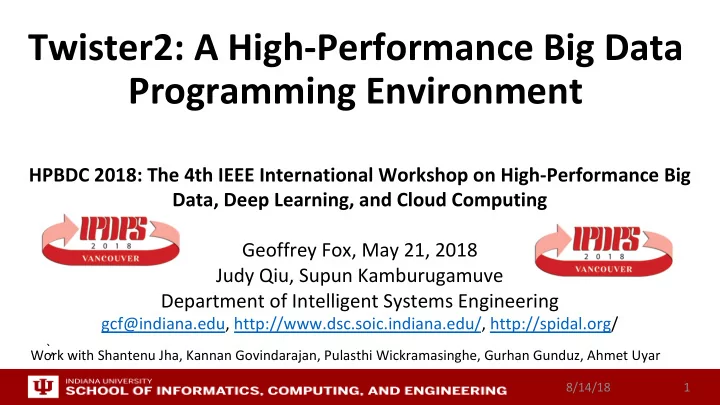

Twister2: A High-Performance Big Data Programming Environment HPBDC 2018: The 4th IEEE International Workshop on High-Performance Big Data, Deep Learning, and Cloud Computing Geoffrey Fox, May 21, 2018 Judy Qiu, Supun Kamburugamuve Department of Intelligent Systems Engineering gcf@indiana.edu, http://www.dsc.soic.indiana.edu/, http://spidal.org/ `, Work with Shantenu Jha, Kannan Govindarajan, Pulasthi Wickramasinghe, Gurhan Gunduz, Ahmet Uyar 8/14/18 1
Abstract • We analyse the components that are needed in programming environments for Big Data Analysis Systems with scalable HPC performance and the functionality of ABDS – the Apache Big Data Software Stack. • One highlight is Harp-DAAL which is a machine library exploiting the Intel node library DAAL and HPC communication collectives within the Hadoop ecosystem. • Another highlight is Twister2 which consists of a set of middleware components to support batch or streaming data capabilities familiar from Apache Hadoop, Spark, Heron and Flink but with high performance • Twister2 covers bulk synchronous and data flow communication; task management as in Mesos, Yarn and Kubernetes; dataflow graph execution models; launching of the Harp-DAAL library; streaming and repository data access interfaces, in-memory databases and fault tolerance at dataflow nodes. • Similar capabilities are available in current Apache systems but as integrated packages which do not allow needed customization for different application scenarios. 8/14/18 2
Requirements • On general principles parallel and distributed computing have different requirements even if sometimes similar functionalities • Apache stack ABDS typically uses distributed computing concepts • For example, Reduce operation is different in MPI (Harp) and Spark • Large scale simulation requirements are well understood • Big Data requirements are not agreed but there are a few key use types 1) Pleasingly parallel processing (including local machine learning LML ) as of different tweets from different users with perhaps MapReduce style of statistics and visualizations; possibly Streaming 2) Database model with queries again supported by MapReduce for horizontal scaling 3) Global Machine Learning GML with single job using multiple nodes as classic parallel computing 4) Deep Learning certainly needs HPC – possibly only multiple small systems • Current workloads stress 1) and 2) and are suited to current clouds and to Apache Big Data Software (with no HPC) • This explains why Spark with poor GML performance can be so successful 8/14/18 3
Need a toolkit covering all applications with same API but different implementations Difficulty in Parallelism Size of Synchronization constraints Tightly Coupled Loosely Coupled HPC Clouds/Supercomputers HPC Clouds Commodity Clouds Memory access also critical High Performance Interconnect Size of MapReduce as in Unstructured Adaptive Sparsity Global Machine Disk I/O Deep Learning scalable databases Medium size Jobs Learning e.g. parallel Pleasingly Parallel Graph Analytics e.g. clustering LDA Often independent events subgraph mining Linear Algebra at core Current major Big Large scale (typically not sparse) Data category simulations Parameter sweep Structured Adaptive Sparsity simulations Huge Jobs Spectrum of Applications and Algorithms Exascale Supercomputers There is also distribution seen in grid/edge computing 8/14/18 4
Need a toolkit covering 5 main paradigms with same API but different implementations Note Problem and System Architecture as efficient execution says they must match Global Machine Learning These 3 are focus of Twister2 but we need to preserve Classic Cloud Workload capability on first 2 paradigms 8/14/18 5
Comparing Spark, Flink and MPI • On Global Machine Learning GML. 8/14/18 6
Machine Learning with MPI, Spark and Flink • Three algorithms implemented in three runtimes • Multidimensional Scaling (MDS) • Terasort • K-Means (drop as no time and looked at later) • Implementation in Java • MDS is the most complex algorithm - three nested parallel loops • K-Means - one parallel loop • Terasort - no iterations • With care, Java performance ~ C performance • Without care, Java performance << C performance (details omitted) 8/14/18 7
Multidimensional Scaling: 3 Nested Parallel Sections Kmeans also bad – see later Flink Spark MPI MPI Factor of 20-200 Faster than Spark/Flink MDS execution time with 32000 points on varying number of nodes . MDS execution time on 16 nodes Each node runs 20 parallel tasks with 20 processes in each node with Spark, Flink No Speedup varying number of points 8/14/18 8
Terasort Sorting 1TB of data records Terasort execution time in 64 and 32 nodes. Only MPI shows the sorting time and communication time as other two frameworks doesn't provide a clear method to accurately measure them. Sorting time includes data save time. MPI-IB - MPI with Infiniband Partition the data using a sample and regroup 9
Software HPC-ABDS HPC-FaaS 8/14/18 10
NSF 1443054: CIF21 DIBBs: Middleware and High Performance Analytics Libraries for Scalable Data Science Ogres Application Analysis HPC-ABDS and HPC- FaaS Software Harp and Twister2 Building Blocks Software: MIDAS HPC-ABDS SPIDAL Data Analytics Library 8/14/18 11
Recommend
More recommend